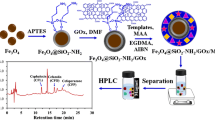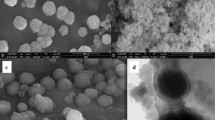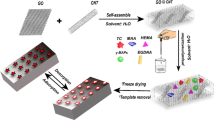Abstract
A composite magnetic adsorbent was developed by embedding graphene quantum dots (GQDs), silica-modified magnetite (Fe3O4-SiO2), and mesoporous carbon (MPC) into a molecularly imprinted polymer (GQDs/Fe3O4-SiO2/MPC/MIP). The adsorbent was applied to extract nonsteroidal anti-inflammatory drugs (NSAIDs) in milk. The MIP was formed via a sol–gel copolymerization using flurbiprofen, diflunisal, and mefenamic acid as template molecules, 3-aminopropyltriethoxysilane as a monomer, and tetraethyl orthosilicate as a cross-linker. GQDs and MPC enhanced affinity binding between NSAIDs and the adsorbent through π-π stacking, hydrogen bonding, and hydrophobic interaction. The Fe3O4-SiO2 nanoparticles embedded in the composite adsorbent enabled its rapid isolation from the sample solution. The extracted NSAIDs were quantified by high-performance liquid chromatography and exhibited good linearity from 1.0 to 100.0 μg L−1 for flurbiprofen and 0.5 to 100.0 μg L−1 for diflunisal and mefenamic acid, respectively. The limits of detection ranged from 0.5 to 1.0 μg L−1. Recoveries of NSAIDs from spiked milk samples ranged from 81.4 to 93.7%, with RSDs below 7%. The reproducibility of the fabricated adsorbent was good and in the optimal conditions, the developed adsorbent could be used for up to six extraction-desorption cycles.
Graphical Abstract





Similar content being viewed by others
References
Baile P, Vidal L, Canals A (2019) A modified zeolite/iron oxide composite as a sorbent for magnetic dispersive solid-phase extraction for the preconcentration of nonsteroidal anti-inflammatory drugs in water and urine samples. J Chromatogr A 1603:33–43. https://doi.org/10.1016/j.chroma.2019.06.039
Tanwar S, Di Carro M, Magi E (2015) Innovative sampling and extraction methods for the determination of nonsteroidal anti-inflammatory drugs in water. J Pharm Biomed Anal 106:100–106. https://doi.org/10.1016/j.jpba.2014.10.027
Golzari Aqda T, Behkami S, Bagheri H (2018) Porous eco-friendly fibers for on-line micro solid-phase extraction of nonsteroidal anti-inflammatory drugs from urine and plasma samples. J Chromatogr A 1574:18–26. https://doi.org/10.1016/j.chroma.2018.08.055
Hassan M, Alshana U (2019) Switchable-hydrophilicity solvent liquid-liquid microextraction of non-steroidal anti-inflammatory drugs from biological fluids prior to HPLC-DAD determination. J Pharm Biomed Anal 174:509–517. https://doi.org/10.1016/j.jpba.2019.06.023
Medina GS, Acquaviva A, Reta M (2020) Development of monolithic sorbent cartridges (m-SPE) for the extraction of non-steroidal anti-inflammatory drugs from surface waters and their determination by HPLC. Microchem J 159:105447. https://doi.org/10.1016/j.microc.2020.105447
Liang S, Jian N, Cao J, Zhang H, Li J, Xu Q, Wang C (2020) Rapid, simple and green solid phase extraction based on polyaniline nanofibers-mat for detecting non-steroidal anti-inflammatory drug residues in animal-origin food. Food Chem 328:127097. https://doi.org/10.1016/j.foodchem.2020.127097
Barfi B, Asghari A, Rajabi M, GoochaniMoghadam A, Mirkhani N, Ahmadi F (2015) Comparison of ultrasound-enhanced air-assisted liquid-liquid microextraction and low-density solvent-based dispersive liquid-liquid microextraction methods for determination of nonsteroidal anti-inflammatory drugs in human urine samples. J Pharm Biomed Anal 111:297–305. https://doi.org/10.1016/j.jpba.2015.03.034
Zhou Y, Xu J, Lu N, Wu X, Zhang Y, Hou X (2021) Development and application of metal-organic framework@GA based on solid-phase extraction coupling with UPLC-MS/MS for the determination of five NSAIDs in water. Talanta 225:121846. https://doi.org/10.1016/j.talanta.2020.121846
Peña-Velasco G, Hinojosa-Reyes L, Escamilla-Coronado M, Turnes-Palomino G, Palomino-Cabello C, Guzmán-Mar JL (2020) Iron metal-organic framework supported in a polymeric membrane for solid-phase extraction of anti-inflammatory drugs. Anal Chim Acta 1136:157–167. https://doi.org/10.1016/j.aca.2020.09.049
Ferrone V, Carlucci M, Ettorre V, Cotellese R, Palumbo P, Fontana A, Siani G, Carlucci G (2018) Dispersive magnetic solid phase extraction exploiting magnetic graphene nanocomposite coupled with UHPLC-PDA for simultaneous determination of NSAIDs in human plasma and urine. J Pharm Biomed Anal 161:280–288. https://doi.org/10.1016/j.jpba.2018.08.005
Kaewsuwan W, Kanatharana P, Bunkoed O (2017) Dispersive magnetic solid phase extraction using octadecyl coated silica magnetite nanoparticles for the extraction of tetracyclines in water samples. J Anal Chem 72(9):957–965. https://doi.org/10.1134/S1061934817090143
Bunkoed O, Nurerk P, Wannapob R, Kanatharana P (2016) Polypyrrole-coated alginate/magnetite nanoparticles composite sorbent for the extraction of endocrine-disrupting compounds. J Sep Sci 39(18):3602–3609. https://doi.org/10.1002/jssc.201600647
Orachorn N, Bunkoed O (2021) Nanohybrid magnetic composite optosensing probes for the enrichment and ultra-trace detection of mafenide and sulfisoxazole. Talanta 228:122237. https://doi.org/10.1016/j.talanta.2021.122237
Hong RY, Feng B, Chen LL, Liu GH, Li HZ, Zheng Y, Wei DG (2008) Synthesis, characterization and MRI application of dextran-coated Fe3O4 magnetic nanoparticles. Biochem Eng J 42(3):290–300. https://doi.org/10.1016/j.bej.2008.07.009
Socas-Rodríguez B, Hernández-Borges J, Salazar P, Martín M, Rodríguez-Delgado MÁ (2015) Core-shell polydopamine magnetic nanoparticles as sorbent in micro-dispersive solid-phase extraction for the determination of estrogenic compounds in water samples prior to high-performance liquid chromatography-mass spectrometry analysis. J Chromatogr A 1397:1–10. https://doi.org/10.1016/j.chroma.2015.04.010
Hu F, MacRenaris KW, Waters EA, Liang T, Schultz-Sikma EA, Eckermann AL, Meade TJ (2009) Ultrasmall, water-soluble magnetite nanoparticles with high relaxivity for magnetic resonance imaging. J Phys Chem C 113(49):20855–20860. https://doi.org/10.1021/jp907216g
Orachorn N, Bunkoed O (2019) A nanocomposite fluorescent probe of polyaniline, graphene oxide and quantum dots incorporated into highly selective polymer for lomefloxacin detection. Talanta 203:261–268. https://doi.org/10.1016/j.talanta.2019.05.082
Villa CC, Sánchez LT, Valencia GA, Ahmed S, Gutiérrez TJ (2021) Molecularly imprinted polymers for food applications: a review. Trends Food Sci Technol 111:642–669. https://doi.org/10.1016/j.tifs.2021.03.003
Chullasat K, Kanatharana P, Bunkoed O (2019) Nanocomposite optosensor of dual quantum dot fluorescence probes for simultaneous detection of cephalexin and ceftriaxone. Sens Actuators B Chem 281:689–697. https://doi.org/10.1016/j.snb.2018.11.003
Chullasat K, Nurerk P, Kanatharana P, Davis F, Bunkoed O (2018) A facile optosensing protocol based on molecularly imprinted polymer coated on CdTe quantum dots for highly sensitive and selective amoxicillin detection. Sens Actuators B Chem 254:255–263. https://doi.org/10.1016/j.snb.2017.07.062
Wei X, Yu M, Li C, Gong X, Qin F, Wang Z (2018) Magnetic nanoparticles coated with a molecularly imprinted polymer doped with manganese-doped ZnS quantum dots for the determination of 2,4,6-trichlorophenol. Microchim Acta 185(4):208. https://doi.org/10.1007/s00604-018-2742-5
Henna TK, Pramod K (2020) Graphene quantum dots redefine nanobiomedicine. Mater Sci Eng C 110:110651. https://doi.org/10.1016/j.msec.2020.110651
Mahmoudi-Moghaddam H, Tajik S, Beitollahi H (2019) A new electrochemical DNA biosensor based on modified carbon paste electrode using graphene quantum dots and ionic liquid for determination of topotecan. Microchem J 150:104085. https://doi.org/10.1016/j.microc.2019.104085
Li Y, Xiao Y, Tao Q, Yu M, Zheng L, Yang S, Ding G, Dong H, Xie X (2021) Selective coordination and localized polarization in graphene quantum dots: Detection of fluoride anions using ultra-low-field NMR relaxometry. Chin Chem Lett 32(12):3921–3926. https://doi.org/10.1016/j.cclet.2021.05.014
Nesakumar N, Srinivasan S, Alwarappan S (2022) Graphene quantum dots: Synthesis, properties, and applications to the development of optical and electrochemical sensors for chemical sensing. Microchim Acta 189(7):258. https://doi.org/10.1007/s00604-022-05353-y
Dong Y, Shao J, Chen C, Li H, Wang R, Chi Y, Lin X, Chen G (2012) Blue luminescent graphene quantum dots and graphene oxide prepared by tuning the carbonization degree of citric acid. Carbon 50(12):4738–4743. https://doi.org/10.1016/j.carbon.2012.06.002
Fu R-w, Li Z-h, Liang Y-r, Li F, Xu F, Wu D-c (2011) Hierarchical porous carbons: design, preparation, and performance in energy storage. New Carbon Mater 26(3):171–179. https://doi.org/10.1016/S1872-5805(11)60074-7
Ni J, Zhao T, Tang L, Qiu P, Jiang W, Wang L, Xu P, Luo W (2020) Solution-phase synthesis of ordered mesoporous carbon as resonant-gravimetric sensing material for room-temperature H2S detection. Chin Chem Lett 31(6):1680–1685. https://doi.org/10.1016/j.cclet.2019.11.025
Fan G, Ge J, Kim H-Y, Ding B, Al-Deyab SS, El-Newehy M, Yu J (2015) Hierarchical porous carbon nanofibrous membranes with an enhanced shape memory property for effective adsorption of proteins. RSC Adv 5(79):64318–64325. https://doi.org/10.1039/C5RA11627A
Xu Z, Li L, Li K, Chen M-L, Tu J, Chen W, Zhu S-H, Cheng Y-H (2021) Peroxidase-mimetic activity of a nanozyme with uniformly dispersed Fe3O4 NPs supported by mesoporous graphitized carbon for determination of glucose. Microchim Acta 188(12):421. https://doi.org/10.1007/s00604-021-05035-1
Wu Y, Cao J-P, Zhuang Q-Q, Zhao X-Y, Zhou Z, Wei Y-L, Zhao M, Bai H-C (2021) Biomass-derived three-dimensional hierarchical porous carbon network for symmetric supercapacitors with ultra-high energy density in ionic liquid electrolyte. Electrochim Acta 371:137825. https://doi.org/10.1016/j.electacta.2021.137825
Acknowledgements
The authors thank Mr. Thomas Duncan Coyne for English proofreading.
Funding
This work was financially supported by the Prince of Songkla University (Grant No. SCI6502007S-0) and The Center of Excellence for Innovation in Chemistry (PERCH-CIC), Ministry of Higher Education, Science, Research and Innovation. Naphatsakorn Orachorn was supported by the Science Achievement Scholarship of Thailand (SAST).
The authors declare no competing interests.
Author information
Authors and Affiliations
Corresponding author
Additional information
Publisher's Note
Springer Nature remains neutral with regard to jurisdictional claims in published maps and institutional affiliations.
Supplementary Information
Below is the link to the electronic supplementary material.
Rights and permissions
Springer Nature or its licensor (e.g. a society or other partner) holds exclusive rights to this article under a publishing agreement with the author(s) or other rightsholder(s); author self-archiving of the accepted manuscript version of this article is solely governed by the terms of such publishing agreement and applicable law.
About this article
Cite this article
Orachorn, N., Bunkoed, O. A composite adsorbent of graphene quantum dots, mesoporous carbon, and molecularly imprinted polymer to extract nonsteroidal anti-inflammatory drugs in milk. Microchim Acta 189, 446 (2022). https://doi.org/10.1007/s00604-022-05550-9
Received:
Accepted:
Published:
DOI: https://doi.org/10.1007/s00604-022-05550-9




